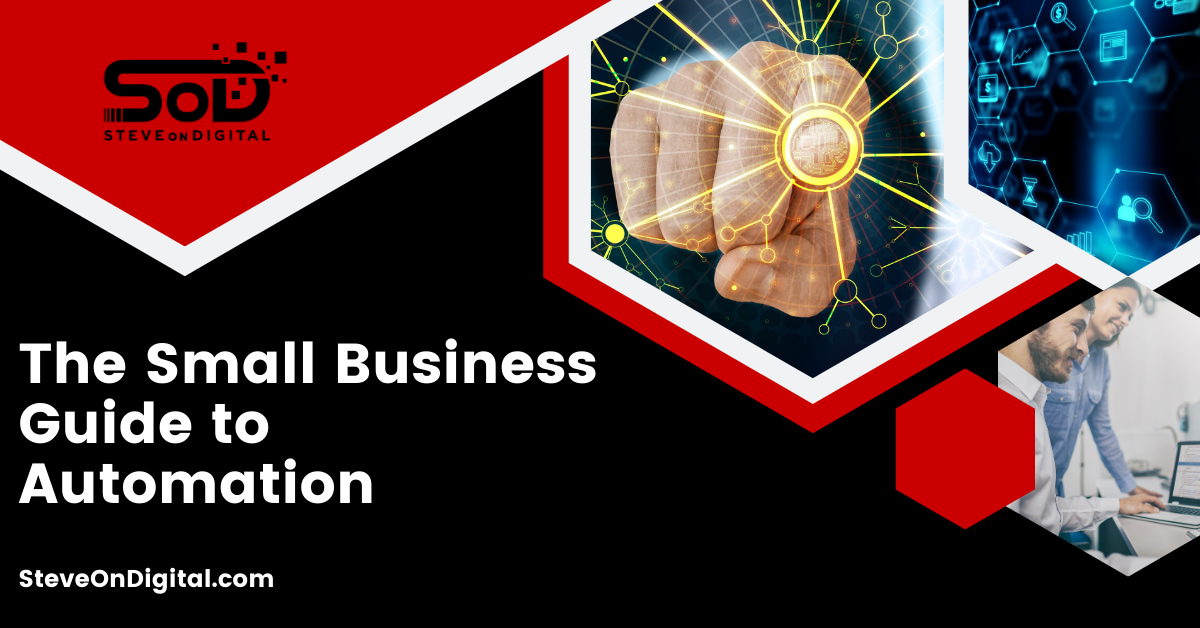Hello everyone, Steve Johnston here from SteveOnDigital.
Today, I’m excited to share my insights and experiences on how small businesses can harness the power of automation.
This guide is built on real data and practices that can truly transform how you operate daily. So, let’s dive in!
The Small Business Guide to Automation: An Introduction
What And Why?
Business automation means using technology to do regular tasks or jobs in a business that people usually do by hand.
This is crucial for small businesses because it not only helps to enhance efficiency by streamlining operations but also allows you to focus more on strategic tasks that drive business growth.
Incorporating small business automation into your operations can further streamline and automate repetitive tasks, significantly boosting productivity and allowing for an even greater focus on innovation and strategic growth.
Enhancing Small Business Operations
Automation can significantly boost the operations of a small business by helping to automate repetitive tasks.
Enhancing efficiency through strategic automation allows small businesses to reduce time spent on administrative tasks, decrease errors in data entry, and speed up the response time to leads and customer inquiries (Paperform) (CRMside).
In today’s digital age, staying competitive often means being able to act quickly and efficiently, and automation provides just that leverage.
Implementing automation in small business operations is a key strategy for unlocking new levels of efficiency, scalability, and growth, ultimately leading to enhanced customer satisfaction.
| Benefit | Description | Estimated Impact |
| Efficiency | Reduces time spent on administrative tasks | Up to 50% time savings (Source: CRMside) |
| Cost Reduction | Decreases operational costs by automating routine tasks | 20% cost reduction (Source: MarketSplash) |
| Customer Satisfaction | Improves response times and service quality | Increases customer retention by 25% (Source: Paperform) |
Identifying Opportunities For Automation
Common Manual Tasks Suitable
In my experience running a digital transformation consultancy, I’ve noticed a pattern in tasks that small businesses can automate effectively:
- Data Entry and Reporting: Automating these tasks can reduce errors significantly (Paperform).
- Customer Service Responses: Using chatbots or automated email responses can ensure that customer inquiries are handled quickly, improving overall customer satisfaction (Paperform).
- Inventory and Project Management: Automated systems can help track and manage inventory and projects without the constant need for manual updates.
Benefits Of Automating Repetitive And Mundane Tasks
The benefits of automation are clear and measurable.
For instance, automating routine tasks can lead to a 20% reduction in operational costs (MarketSplash).
It also allows employees to focus on more critical, rewarding work, which can lead to higher job satisfaction and productivity.
Automation in marketing, for example, has been shown to increase leads by up to 80% and enhance conversion rates significantly (Paperform) (Workato).
From personal experience, implementing customer relationship management (CRM) systems has transformed how my business manages interactions with clients.
It streamlined our processes, reduced the workload on our team, and enhanced our customer engagement strategies.
Key Automation Areas For Small Businesses
Customer Service
For small businesses, customer service is a crucial battleground.
Here’s how automation can help:
- Automated Customer Support: Implementing chatbots and automated ticketing systems, key components of customer service automation, can drastically reduce response times and improve customer satisfaction. Automation tools enhance customer satisfaction by providing timely and efficient service, ensuring that customer inquiries are addressed promptly and accurately.
- Feedback and Follow-Up Automation: Systems that automatically ask for and track customer feedback contribute to an enhanced customer experience by ensuring customer feedback is promptly addressed, allowing businesses to quickly adapt and improve their service offerings.
Sales And Marketing
Automation in sales and marketing not only saves time but also ensures that no lead is left behind:
- Lead Management Tools: Automated systems can help manage the sales pipeline more efficiently, ensuring that each lead is nurtured and followed up on. Utilizing sales automation tools can significantly enhance productivity and efficiency in managing the sales pipeline, streamlining processes to save time, reduce errors, and improve customer relationships.
- Marketing Campaigns: A marketing automation tool like DirectLync can be particularly beneficial for email and social media automation, helping maintain a consistent online presence without the need for daily input from staff. These tools highlight the benefits for small businesses and marketing teams with limited resources, leading to higher efficiency, productivity boost, and time and resource savings.
Operations
Operational efficiency is vital for maintaining profitability in a small business:
- Project Management Automation: Tools like Asana and Trello can automate workflow, assign tasks, and follow up on project progress.
- Inventory Management Systems: Automated tracking of stock levels and orders can help prevent overstocking or stockouts, saving costs and optimizing operations.
| Area | Tasks Suitable for Automation | Tools Recommended |
| Customer Service | Ticketing, Chatbots | Zendesk, Intercom |
| Sales | Lead management, Follow-ups | HubSpot, Salesforce |
| Marketing | Social media posting, Email marketing | Hootsuite, Mailchimp |
Selecting The Right Automation Tools
Overview Of Automation Tools
When it comes to choosing automation tools, there are many options, each with specific features tailored to different aspects of business:
- Customer Relationship Management (CRM) Systems: Tools like Salesforce or HubSpot integrate various functions to streamline customer interactions and sales processes.
- Marketing Automation Tools: Platforms such as Mailchimp or Hootsuite offer robust support for email campaigns and social media management.
| Tool | Function | Best For | Approx. Cost |
| Salesforce | CRM | Customer Relationship Management | $$$ |
| Asana | Project Management | Task and Project Coordination | $$ |
| Mailchimp | Marketing Automation | Email Campaigns | $$ |
How To Choose Tools That Fit Your Business Needs And Budget
Selecting the right tools can be challenging, but here’s how you can make it simpler:
- Assess Your Needs: Understand which processes need automation and to what extent.
- Budget Allocation: Determine how much you’re willing to invest in automation tools. Remember, the initial costs might be high, but the long-term savings and benefits often justify the investment.
- Scalability and Integration: Choose tools that can grow with your business and seamlessly integrate with your existing systems.
Through my own experiences in digitizing businesses, I’ve found that the right automation tools not only save time but also enhance customer experiences and streamline operations.

They’ve been fundamental in how we handle repetitive tasks, manage customer relationships, and push forward our marketing efforts, all while keeping tight control on labor costs and improving our service quality.
Implementing Automation In Your Business
Steps To Plan And Deploy
- Assessment of Needs: Begin by identifying which processes within your business can and should be automated. Look for repetitive tasks and areas where precision and consistency are required.
- Choosing the Right Tools: Select automation tools that fit the specific needs identified. This may include customer relationship management systems, workflow automation tools, or specific marketing automation tools.
- System Integration: Carefully plan how these tools will integrate with your current systems. Seamless integration is key to maintaining uninterrupted operations.
- Pilot Testing: Before full implementation, run a pilot test to ensure the automation works as expected and refine any processes in response to the findings.
| Step | Description | Tips |
| Assessment | Identify processes that need automation | Focus on repetitive, high-volume tasks |
| Tool Selection | Choose the right tools based on needs and budget | Consider scalability and integration capabilities |
| Integration | Seamlessly integrate tools with existing systems | Use APIs for smooth data flow between platforms |
Integration Strategies
- API Utilization: Use APIs to connect new automation tools with existing software, ensuring that data flows smoothly between systems.
- Data Consolidation: Ensure all systems work from a single source of truth, reducing data silos and enhancing data accuracy.
- Continuous Monitoring and Adjustment: Monitor the performance of integrated systems and make adjustments as needed to optimize performance.
Training Resources And Support For Effective Utilization
- Staff Training: Conduct comprehensive training sessions to ensure all team members are proficient in using the new tools.
- Ongoing Support: Set up a support system for addressing any issues that arise post-implementation.
- Feedback Loop: Establish a feedback loop with your team to continually improve the use and effectiveness of the automation tools.
Optimizing Business Processes Through Automation
Workflow Automation
Automating workflows can lead to significant improvements in both service quality and operational efficiency.
By automating key processes, businesses can ensure tasks are completed on time and with fewer errors, leading to a more reliable service delivery.
Using CRM Systems
- Centralized Customer Information: A CRM system provides a centralized platform for all customer information, which enhances communication and service delivery.
- Automated Customer Interactions: Automate scheduling, follow-ups, and customer service inquiries to improve engagement and responsiveness.
- Feedback Collection and Analysis: Use automated tools within your CRM to collect and analyze customer feedback, which can guide future improvements in products and services.
By following these guidelines and focusing on strategic automation, small businesses can achieve a higher degree of efficiency and customer satisfaction.
Implementing these systems may require an upfront investment, but the long-term benefits of automation in saving time, reducing costs, and improving service quality are undeniable.
Monitoring And Refining Automated Systems
Tracking Progress And Team Productivity
Implementing automation is just the beginning.
Here’s how you can continuously monitor and refine these systems:
- Use Dashboards: Most automation tools come with dashboards that provide real-time data on various metrics. Utilize these to track everything from sales figures to customer engagement.
- Monitor Team Productivity: Automation should ideally free up your team’s time for more strategic tasks. Use productivity tracking tools to ensure this is the case, and adjust workflows as necessary to optimize team output.
Data Analysis For Continuous Improvement
- Gather and Analyze Data: Automation tools collect vast amounts of data that can provide insights into business processes and customer behavior. Regular analysis of this data can help identify trends, pinpoint inefficiencies, and suggest areas for cost reduction.
- Cost Tracking and Reduction: With detailed data from your automated systems, track your cost savings and ROI. Automation should lead to a decrease in labor costs and operational expenses. If this isn’t the case, it might be time to tweak your processes.
| Metric | Method of Measurement | Target Outcome |
| Productivity | Track output pre- and post-automation | Increase by 30% |
| Customer Engagement | Monitor customer interaction metrics | Improve response times by 50% |
| ROI | Calculate cost savings vs. initial investment | Achieve break-even within 1 year |
Advanced Automation Strategies
Leveraging AI And Machine Learning
As we look towards the future, AI and machine learning are transforming automation from simple task execution to complex decision-making support.
- Predictive Analytics: Use AI to predict customer behavior and business outcomes effectively. This can help in fine-tuning marketing strategies and inventory management.
- Enhanced Customer Interactions: AI-driven chatbots and virtual assistants can provide a level of interaction that feels personalized and responsive, enhancing customer satisfaction and engagement. AI-driven tools are key to enhancing customer engagement by delivering personalized messages and reaching the audience instantly, which drives conversions.
Future Trends In Automation
- Integration of IoT: The Internet of Things (IoT) is set to revolutionize automation by connecting physical devices to automation systems. This could transform everything from supply chain management to customer service.
- Robotic Process Automation (RPA): RPA is gaining traction for its ability to perform repetitive tasks quickly and accurately. As this technology becomes more accessible, it could become a game changer for small businesses looking to automate more complex processes.
As small business owners, staying ahead of these trends and continuously adapting our automation strategies is crucial for staying competitive.
By embracing these advanced technologies, we can enhance our operational efficiency, improve customer experiences, and drive our businesses toward greater success.
Building A Sustainable Automation Framework
Creating Scalable Automation Solutions
- Flexibility is Key: Choose automation solutions that offer flexibility to scale up or down based on business needs. This could mean opting for cloud-based solutions that allow you to add more features or capacity as your business grows.
- Modular Implementations: Start with automating small, manageable sections of your operations. This modular approach makes it easier to troubleshoot issues and scale effectively.
Addressing Common Challenges
- Overcoming Staff Resistance: Change can often be met with resistance. It’s vital to involve your team in the automation process from the beginning, emphasizing the benefits and training them to use new systems effectively.
- Integration Complexities: Integrating new automation tools with existing systems can be challenging. Hiring experts or using integration platforms can help smooth this process, ensuring that your business operations run seamlessly.
The Impact of Automation on Business Growth
Assessing The Return On Investment (ROI)
- Cost vs. Benefit Analysis: Measure the initial costs against long-term savings, such as reduced labor costs, improved operational efficiency, and lower error rates. Typically, automation leads to significant cost savings over time, making the initial investment worthwhile.
- Performance Metrics: Track performance improvements in areas like customer service response times, lead conversion rates, and production times to clearly see the benefits of automation.
Case Studies
- Local Retail Store: A local retail store implemented a CRM system to manage their customer relationships more effectively. This automation resulted in a 25% increase in repeat business within the first year by improving customer follow-up and satisfaction.
- Manufacturing SME: A small manufacturing firm used automation to streamline their inventory and order management processes. This not only reduced their operational costs by 15% but also improved their ability to meet customer demand more promptly.
Through my journey with SteveOnDigital, I’ve seen first-hand how automation has transformed operations, making them more efficient and responsive.
For us, automating routine tasks allowed the team to focus more on strategic goals, which drove significant growth in service quality and client satisfaction.

As we wrap up this part of our guide, remember that the goal of automation should be to enhance your business processes, making them more efficient and effective.
Whether it’s through improving customer interactions, optimizing operational tasks, or providing valuable insights into your business performance, automation can be a game-changer for your growth trajectory.
Future Outlook And Preparing for Next-Gen Automation
Emerging Automation Technologies And Their Potential
- Artificial Intelligence and Machine Learning: These technologies are set to redefine automation by making systems more intelligent and capable of predictive decision-making. For small businesses, this could mean smarter CRM systems that anticipate customer needs and buying patterns.
- Internet of Things (IoT): IoT technology integrates physical devices with automation systems. For small businesses, this can optimize everything from energy use in your facilities to inventory management in real-time.
- Robotic Process Automation (RPA): RPA is becoming more accessible and can take over repetitive tasks across various departments—from accounting to customer service—freeing up your team for more complex tasks.
Preparing Your Business For Future Automation Advances
- Stay Informed: Keep up with the latest trends in technology by attending webinars, reading industry publications, and participating in tech forums.
- Invest in Training: Ensure that your team is comfortable with technology. Regular training sessions on new tools and systems can demystify automation and encourage adoption.
- Upgrade Gradually: Implement new technologies in stages rather than all at once to minimize disruption and allow for adjustments as your team and operations adapt.
Conclusion
Summary
Automation brings myriad benefits to small businesses:
- Efficiency Gains: Automated processes are typically faster and more reliable than manual ones, allowing for increased productivity.
- Cost Savings: Though initial setup costs can be high, the long-term savings on labor and operational efficiencies can be substantial.
- Improved Customer Experience: Automation can ensure that your customer interactions are consistent and personalized, leading to higher satisfaction and loyalty.
Encouraging Small Business Owners
As a fellow small business owner, I encourage you to consider how automation can be integrated into your business model.
It’s not just about staying relevant; it’s about thriving in an increasingly competitive market.
Automation can give you the tools to enhance your operations, understand your customers better, and ultimately drive growth.
By embracing these technologies, we position our businesses to take advantage of new opportunities and meet future challenges head-on.
Let’s step into the future together, equipped with the tools to succeed.
Remember, the journey to automation is ongoing, and staying adaptable is key to leveraging its full potential for your business success.





